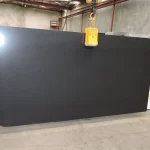Granite is a natural stone that is well-known for its longevity, adaptability, and aesthetic appeal. In addition to their widespread application in the construction of countertops and other surfaces, granite slabs are also a great option for flooring. Granite slabs are used for flooring, and this article examines the different features of using granite slabs for flooring, including its durability, design alternatives, maintenance requirements, installation issues, and cost implications.
Resilience and longevity
There are several reasons why granite slabs are appropriate for flooring, but one of the most important reasons is that they are exceptionally durable. Granite is a stone that is both durable and dense, and it is able to resist considerable foot activity. Because of this, it is an excellent choice for high-traffic areas in both residential and commercial settings. This flooring is resistant to scratches, impacts, and wear, which ensures that it will continue to preserve its beauty and functionality even in conditions that are particularly demanding. In addition, granite is resistant to heat, which makes it an excellent choice for locations that are subjected to direct sunshine or locations that have underfloor heating systems.
Design Alternatives
The use of granite slabs provides homeowners with a wide variety of design possibilities, which enables them to attain the visual appeal that they desire. Granite is a material that can be found in a wide range of colors and patterns, making it suitable for every interior design style, from traditional to contemporary. Flooring surfaces that are one-of-a-kind and visually appealing are created by the inherent differences that occur in the stone. In addition, granite can be treated in a variety of ways, including polished, honed, or brushed, which provides more design options. Homeowners are able to create individualized flooring designs that improve the overall appearance of their homes by having the flexibility to select from a broad assortment of colors, patterns, and finishes.

Essential Prerequisites for Upkeep
Granite is a flooring material that is reasonably easy to maintain, which makes it an appealing choice for homeowners. Sweeping or vacuuming on a regular basis is required in order to remove dirt, dust, and debris that, over time, might create abrasion. In order to avoid stains from occurring, spills should be cleaned up as soon as possible; however, granite is often resistant to stains when it is properly sealed. A stone cleaner that is gentle and pH-neutral, together with a damp mop or towel, can be used to clean the structure. Scrubbing pads and abrasive cleaners should be avoided at all costs because they have the potential to cause harm to the surface. In order to preserve the protective coating of the granite and to ensure that it will last for a long time, periodic resealing may be required.
Aspects to Consider During Installation
In order to successfully install granite flooring, meticulous planning and the ability to work with professionals are required. Because of the weight of granite slabs, the flooring must be structurally stable in order to sustain the weight of the slabs. Furthermore, in order to provide a level and sturdy surface for the installation, the subfloor needs to be adequately leveled. For the purpose of achieving precise measurements and finishes, the slabs are normally cut and polished away from the construction site. During the process of installation, the slabs are affixed to the subfloor by means of adhesives that are specifically designed for application. It is of the utmost importance to employ skilled installers who are equipped with the essential skills and tools to handle the installation in an appropriate manner.
The Implications of Costs
It is possible for the price of granite flooring to be greater than the price of other flooring materials because granite flooring is considered a luxury option. There are a number of elements that influence the price of granite slabs, including color, scarcity, quality, layer thickness, and thickness. A further consideration that needs to be taken into account is the cost of installation, which includes both the labor and the materials. Granite flooring delivers long-term value due to its durability and timeless aesthetic appeal, despite the fact that the initial expenditure may be more. When making a decision on granite flooring, it is vital to take into consideration the budget, as well as the benefits and the value over the long run.
There are various benefits associated with using granite slabs for flooring, including the fact that they are long-lasting, give a variety of design options, and are convenient to maintain. Granite’s excellent durability means that the flooring will continue to look beautiful even after being subjected to heavy foot activity and will continue to be durable. With the availability of a diverse selection of colors, patterns, and finishes, homeowners are able to create individualized designs that improve the appearance of their interior spaces. It is possible to maintain the granite flooring’s integrity by performing proper maintenance, which includes washing it on a regular basis and resealing it at regular intervals. Considerations regarding the installation process and the effects of the costs should also be thoroughly evaluated. Homeowners may safely choose granite slabs for their flooring needs if they have a thorough awareness of these characteristics, which will result in the creation of a foundation for their homes that is both visually attractive and long-lasting.









